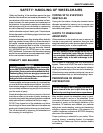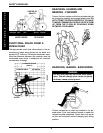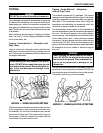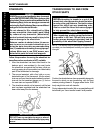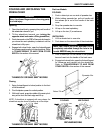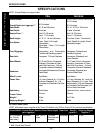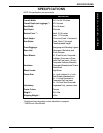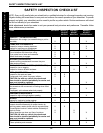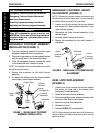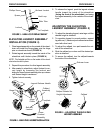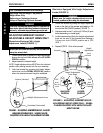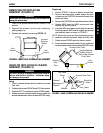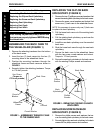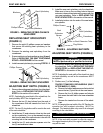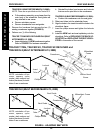
15
TROUBLESHOOTING/MAINTENANCE
M
A
I
N
T
E
N
A
N
C
E
MAINTENANCE
MAINTENANCE SAFETY
PRECAUTIONS
WARNING
After ANY adjustments, repair or service and
BEFORE use, make sure all attaching hardware
is tightened securely - otherwise injury or dam-
age may result.
CAUTION
DO NOT over tighten hardware attaching to
the frame. This could cause damage to the
frame tubing.
SUGGESTED MAINTENANCE
PROCEDURES
1. Before using your wheelchair, make sure all nuts
and bolts are tight. Check all parts for damage or
wear and replace. Check all parts for proper ad-
justment.
2. Keep quick-release axles free of dirt and lint to
ensure positive locking and proper operation. Re-
fer to ADJUSTING THE QUICK-RELEASE AXLE
in PROCEDURE 4 of this manual.
3. If equipped, oil quick-release axles at least once (1)
a month (3-in-1
®
oil
or equivalent).
3-in-1 oil - Registered trademark of American Home
Products Corporation.
T
R
O
U
B
L
E
S
H
O
O
T
I
N
G
TROUBLESHOOTING
4. The wheels and tires should be checked periodi-
cally for cracks and wear, and should be replaced
when necessary by your authorized dealer or by a
qualified technician.
5. Periodically check handrims to ensure they are
securely attached to the rear wheels. Refer to
REPLACING REAR WHEEL HANDRIM in PRO-
CEDURE 4 of this manual.
6. Periodically adjust wheel locks in correlation to tire
wear. Refer to WHEEL LOCK ADJUSTMENT in
PROCEDURE 6 of this manual.
7. Periodically check front caster and rear wheel hubs
to make sure they are clean. Use a Teflon
®
lubri-
cant if necessary.
8. Check Upholstery for sagging, rips or tears.
Teflon - Registered trademark of E.I. Du Pont Nemours
and Company.
CHAIR CHAIR SLUGGISH CASTERS SQUEAKS LOOSENESS CHAIR SOLUTIONS
VEERS VEERS TURN OR FLUTTERS AND IN CHAIR WHEELS
RIGHT LEFT PERFORMANCE RATTLES
X X X X X If pneumatic, check tires
for correct and equal
pressure.
X X X X Check for loose stem
nuts and bolts.
X X X Check that both casters
contact the ground at
the same time.
WARNING
DO NOT use the wheelchair unless it has the
proper tire pressure (p.s.i.). DO NOT overinflate
the tires. Failure to follow these suggestions may
cause the tire to explode and cause bodily harm.
Recommended tire pressure is listed on the side
wall of the tire.



